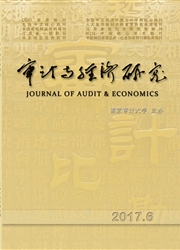

 中文摘要:
中文摘要:
审计机关组织模式有两种,一是纵向集权/横向集中模式,二是纵向集权/横向分割模式。将国家审计作为审计规制,以规制经济学为基础,建立一个解释两种审计机关组织模式下审计效果之差别的理论架构,并用这个理论架构来分析湘潭市审计局的审计"四权分离"模式。结果表明,在纵向集权/横向集中模式下,审计主体被俘获的可能性较大;在纵向集权/横向分割模式下,审计主体被俘获的可能性较小。将审计立项权、审计查证权、审计审理权、审计执行权进行横向分割,具有解决信息不对称、权力分割和权力监督三方面的效果,能够发挥审计规制俘获阻止的功能。湘潭市审计局推行审计权"四分离"的组织模式实现了从纵向集权/横向集中模式向纵向集权/横向分割模式的转换,从而大大降低了审计规制俘获,提高了审计效果。
 英文摘要:
英文摘要:
Based on the allocation of audit power, there are two organization models for national audit office, one is VCP/ HCP, the other is VCP/HSP. This paper takes nation audit office as a regulation based on regulation economics; establishes a theoretical framework to explain why VCP/HSP model is more difficult to be captured than VCP/HCP model. And further, uses this theoretical framework to explain why Xiangtan audit office changes its organization model with effect. Under the VCP/ HSP model, audit powers are separated, in this way, they are able to reduce the information asymmetry, to realize the separation of powers and supervision of power, and prevent the capture of regulation, as a result, the audit effect is improved.
 同期刊论文项目
同期刊论文项目
 同项目期刊论文
同项目期刊论文
 期刊信息
期刊信息
